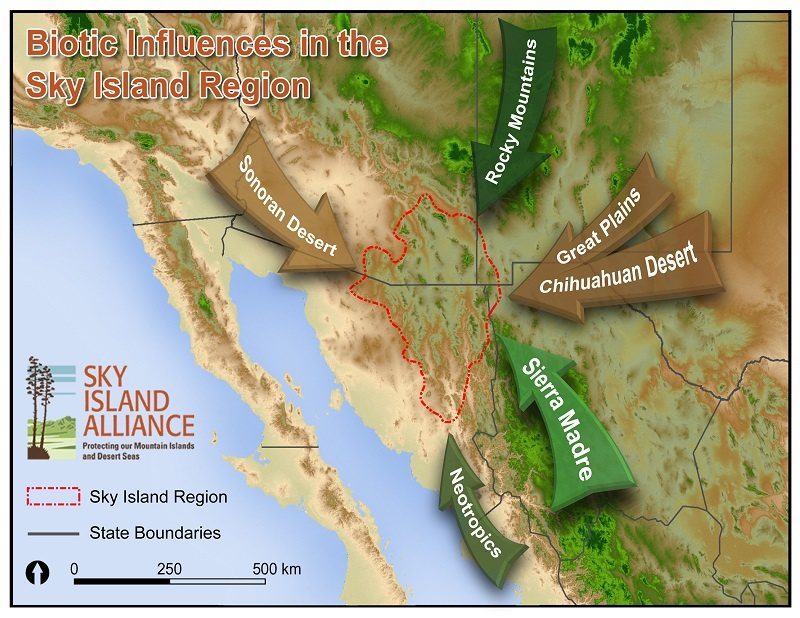Protect the Patagonias
Home //
Six different biological provinces overlap in this region: Rocky Mountains, Sierra Madre, Sonoran Desert, Chihuahuan Desert, Great Plains and Neo Tropics. Each province contributes its own unique variety of plants and animals.
- There are more than 300 species of birds.
- Patagonia is the pollinator capital of the United States with over 600 species of native bees, 300 types of butterflies and moths, 14 hummingbird species and two nectar-feeding bat species.
- The Patagonia range is likely a gateway for jaguars and ocelots traveling to and from breeding grounds in Sonora, Mexico.
- There are currently 112 Federally threatened, endangered and sensitive species in the Patagonia Mountain area.
E O Wilson (American biologist, researcher, theorist, naturalist and author) writing in his latest book “Half Earth: Our Planet’s Fight for Life” makes the point that even though extinction rates are soaring, a great deal of Earth’s biodiversity can still be saved. Wilson contacted 18 of the world’s senior naturalists (each with international expertise in biodiversity and ecology) and asked them to “name one to five places in the world you consider best on the basis of richness, uniqueness, and most in need of research and protection. . . ” Among the top choices are the Madrean mountain chains of Mexico and the Sky Island heights of the southwestern United States.

The Patagonia area is renowned — locally & internationally — by scientists, hikers, birdwatchers, campers, hunters, mountain bikers and outdoor enthusiasts.
The Town of Patagonia is a Gateway Community for the continuous 800 mile Arizona National Scenic Trail connecting Mexico to Utah.
The Patagonia Mountains have likely been inhabited for about 10,000 years. There is archeological evidence of inhabitants during the Archaic period (7000 – 1 BCE). The Hohokam thrived in this area from about 1050 CE to 1450 CE. The Patagonia Mountains were part of Mexico until annexed to the United States through the 1853 Gadsden Purchase.
The communities now known as Patagonia, Sonoita and Elgin were united by the railroad from 1882 to 1962. Following the departure of the railroad and the shutdown of area mining operations, this region’s businesses struggled to establish a reliable economic prosperity. In 1968 the Sonoita Creek was dammed to create Lake Patagonia. In 1969 the Nature Conservancy purchased 312 acres known by locals as “the grove” and that property has grown to an 873 acre riparian habitat known as The Patagonia-Sonoita Creek Preserve. These key events helped establish the region as a destination for natural outdoor activities.
Patagonia has evolved into an eco-tourism destination for visitors from around Arizona, the United States and the world as well as a blossoming eco-community populated with pro-active creative people manifesting a better quality of life for our community members. There are economic activities such as local food production, restoration of ecosystem processes and native habitat, conservation, vineyards and ranching. Numerous businesses (retail stores, restaurants, lodging, health services, food markets, construction) are woven into a diverse economic base that is regenerative and stable. The full fabric of services include our schools, emergency services and community organizations.
Based on the 2016 FYE (June) Town of Patagonia’s sales tax revenue, our local economy grew 421% and our population grew 69% since the mines ceased operations.
Mining activity began locally in the late 1700s with significant activity from 1857 through the early 1960s. The Patagonia Mountains have hundreds of old mine sites, many of which continue to leak a toxic sludge known as acid mine drainage. Mining companies typically walk away from the environmental disasters they create, leaving the taxpayers to bear the cost of clean-up. According to the EPA, the hard rock mining industry produces more toxic waste than any other industry in the USA. Mining has a boom and bust history for local communities.
Several mining companies currently want to re-introduce large scale mining in the area. There is no modern mining that will meet the standards of responsible mining to sufficiently protect the health and vitality of our global biodiversity hotspot ecosystem (especially the water resources).
Founded in 2011, Patagonia Area Resource Alliance (PARA) is a grassroots, non-profit community alliance committed to preserving and protecting the Patagonia Mountains and to empowering local people to steward the exceptional place we inhabit. PARA educates the community about the risks and realities of mining to better understand our precious and imperiled natural resources such as clean water and wildlife and actively advocates for the protection of those resources including Patagonia’s distinct and serene rural way of life.
PARA recognizes that the health and economic prosperity of our community are tied deeply to the well-being of the Patagonia Mountains and the Harshaw/Sonoita Creek watershed. They are the source of our drinking water, air, soil and the biological wealth that drives our local economy.
